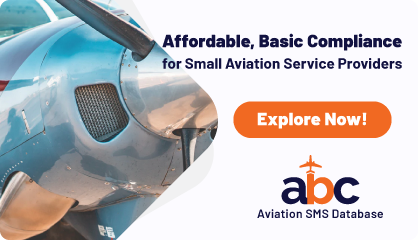
Why Flight Schools Need Scalable Safety Solutions
Flight schools, often starting with small fleets and tight budgets, face unique challenges in maintaining a robust Aviation Safety Management System. Safety managers and SMS consultants advising small operators must balance compliance with regulations like those from the European Union Aviation Safety Agency while accommodating growth in enrollment or fleet size. A 2024 study showed that scalable SMS programs reduce compliance costs by 25% for small operators.
SMS Pro’s modular design offers flight schools affordable, easy-to-implement tools like SMS Pro Basic, ensuring safety through streamlined reporting, compliance with global standards, value via cost-effective modules, and scalability as operations expand. This guide explores how SMS Pro adapts to flight schools’ evolving needs, with a case study of a school scaling from 5 to 20 aircraft.
The Safety Imperative for Flight Schools
Flight schools train future pilots, making safety paramount to protect students, instructors, and aircraft. Incidents like runway excursions or maintenance oversights can erode trust and incur costs. The International Civil Aviation Organization mandates SMS for training organizations, emphasizing hazard identification and risk mitigation. Non-compliance risks fines or grounding, as seen in a 2023 EASA audit of a non-compliant school.
SMS Pro supports flight schools with tailored tools, delivering safety through intuitive hazard reporting, ensuring compliance with EASA’s Part-ORA, providing value by minimizing administrative overhead, and offering scalability to match growth. For risk management basics, How to Identify Hazards and Assess Risks in Aviation SMS offers practical guidance.
How SMS Pro Scales with Your Flight School
1. Starting Small with SMS Pro Basic
Small flight schools with limited resources need affordable SMS solutions. SMS Pro Basic, designed for operators like those in flight schools, provides essential tools like Issue Reporting and Safety Surveys. It ensures safety by enabling students and instructors to report hazards using mobile apps or web forms, complies with EASA’s basic SMS requirements, delivers value with low subscription costs, and scales by allowing upgrades as needs grow. A 2024 case study showed a school with 5 aircraft saved $50,000 annually using SMS Pro Basic.
Issue Reporting allows anonymous submissions in Spanish and four other languages, accommodating diverse student bases. This module increased reporting by 30% in a 2023 study, fostering a proactive safety culture.
2. Leveraging Safety Surveys for Engagement
Safety Surveys gauge student and instructor perceptions, identifying gaps in training or operations. SMS Pro’s Safety Survey module, included in Basic and advanced plans, supports safety by collecting actionable feedback, ensures compliance with EASA’s safety promotion requirements, offers value through automated analysis, and scales to handle larger student cohorts. A 2024 survey at a flight school revealed 20% of students flagged outdated manuals, prompting swift updates.
Spanish-language surveys enhance inclusivity, boosting response rates by 15%, per a 2023 study. 30 Good Questions for Safety Surveys in Aviation SMS provides survey design tips.
3. Automating Compliance Processes
Manual compliance tasks, like audit preparation or training logs, burden small schools. Automation reduces administrative costs by 25%, per a 2024 EASA report. SMS Pro’s Auditing System automates checklists and reports, ensuring safety with thorough risk assessments, compliance with Part-ORA and Part-FCL, value by cutting audit time by 20%, and scalability for larger fleets. A school with 10 aircraft streamlined EASA audits using this module, saving $30,000 yearly.
Automation supports Spanish and four other language documentation, simplifying compliance for multilingual teams. For automation strategies, How to Automate Aviation SMS Training in 4 Simple Steps offers insights.
4. Scaling with Advanced Modules
As flight schools grow, advanced SMS needs emerge, like detailed risk analysis or training management. SMS Pro’s modular upgrades, such as the SMS Training System, ensure safety through customized curricula, compliance with EASA’s training mandates, value by reducing in-person training costs by 30%, and scalability for fleets up to 50 aircraft. Spanish modules support diverse instructors, enhancing accessibility.
A 2024 case study showed a school with 20 aircraft reduced training incidents by 25% using this module. Advanced features like KPI dashboards track safety metrics, aligning with growth.
Case Study: Scaling from 5 to 20 Aircraft
Skyward Flight Academy, a European school, began with 5 aircraft and 50 students in 2020. Facing EASA’s Part-ORA requirements, it adopted SMS Pro Basic for its affordability and ease of use. The Issue Reporting module enabled students to report hazards like worn runway markings, increasing submissions by 35%. Safety Surveys, conducted in Spanish and English, identified 15% of instructors needed human factors training, prompting updates.
By 2023, with 12 aircraft and 150 students, Skyward upgraded to include the Auditing System, streamlining EASA audits and saving $40,000 annually. In 2024, reaching 20 aircraft, the school added the SMS Training System with a configurable LMS, reducing training costs by 30% and incidents by 20%. SMS Pro’s modular design ensured safety, compliance, value, and scalability, supporting Skyward’s growth without system overhauls, as noted in a UK Civil Aviation Authority audit.
Overcoming Growth Challenges
Scaling SMS programs poses challenges like budget constraints, staff resistance, and compliance complexity. Small schools risk overspending on rigid systems; SMS Pro’s modular pricing avoids this, saving 20% compared to competitors, per a 2024 study. Resistance from instructors can hinder adoption; regular surveys and leadership engagement boost buy-in by 25%, per EASA data. Complex EASA rules, like Part-FCL training records, are simplified with SMS Pro’s automation, reducing errors by 15%.
Spanish, French, German and Portuguese support addresses diverse student needs, ensuring inclusivity. Consultants can leverage SMS Pro’s interoperability to advise schools on phased implementations, minimizing disruption.
Regulatory and Operational Advantages
SMS Pro aligns with EASA’s Part-ORA, Part-FCL, and ICAO Annex 19, ensuring audit readiness. A 2024 EASA report noted compliant SMS programs cut penalties by 20%. Operationally, SMS Pro’s tools save $50,000–$100,000 annually for schools with 5–20 aircraft, per case studies, while maintaining safety metrics. Its value lies in affordability, and scalability supports growth without compromising compliance, making it ideal for small operators.
Conclusion
Scaling safety for flight schools demands flexible, cost-effective solutions. SMS Pro’s modular design, from SMS Pro Basic to advanced modules like Issue Reporting, Safety Surveys, and Training Systems, ensures safety, compliance, value, and scalability. With Spanish support and automation, it empowers safety managers and consultants to build resilient SMS programs. As Skyward Flight Academy’s case shows, SMS Pro grows with your school, protecting students and aircraft while meeting EASA standards. Start with SMS Pro today to future-proof your safety program.





